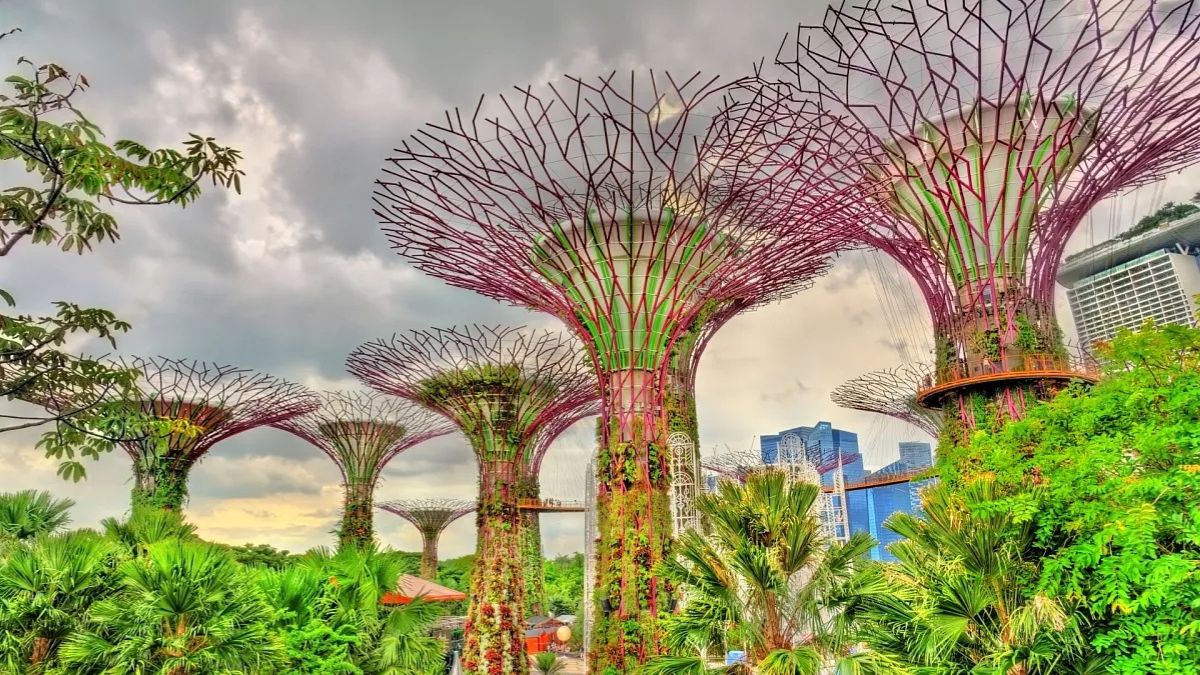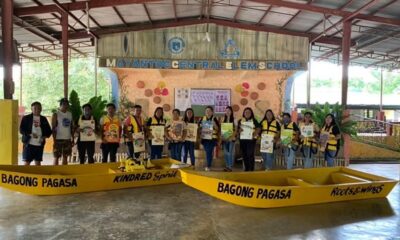TOPIC
Biodiversity in Urban Singapore: Corporate Contributions to Nature-Based Solutions and Green Infrastructure

Singapore, often referred to as a “City in Nature,” has carved out a unique reputation as a global model for integrating urbanization with biodiversity. As the country continues to pursue its Green Plan 2030, corporations are no longer passive participants in environmental efforts. They are now playing an active role in enhancing biodiversity and investing in nature-based solutions (NBS) and green infrastructure to support the city-state’s sustainable development agenda.
This shift in mindset marks a powerful evolution in how businesses perceive and implement sustainability solution companies in Singapore, transforming biodiversity from a peripheral issue into a central pillar of environmental strategy.
The Urgency of Biodiversity Protection in Urban Settings
Urban biodiversity is critical not only for the environment but also for societal well-being. In Singapore’s densely built landscape, preserving native flora and fauna, restoring wetlands, and promoting sustainable green spaces are vital for improving air quality, reducing the heat island effect, and enhancing quality of life.
Singapore’s unique biodiversity — including over 390 species of birds, 2,100 native vascular plants, and 300 species of butterflies — is under continuous pressure due to rapid development. To mitigate these impacts, Singapore’s government has launched major initiatives such as the Singapore Green Plan 2030, the Nature Conservation Masterplan, and the expansion of green corridors like the Park Connector Network (PCN) and Nature Ways. But the success of these plans hinges significantly on private sector collaboration.
Corporate Role in Advancing Biodiversity and Green Infrastructure
Corporations in Singapore are increasingly aligning their sustainability roadmaps with biodiversity and climate resilience goals. This means going beyond traditional CSR (Corporate Social Responsibility) initiatives to adopt science-based targets and systemic environmental planning.
Companies are now supporting biodiversity in the following ways:
- Investing in Nature-Based Solutions
Nature-based solutions such as green roofs, rain gardens, vertical forests, and biodiversity-sensitive landscaping help businesses reduce their carbon footprint while contributing to ecological preservation. For instance, real estate developers are integrating biodiversity features in their building designs to qualify for Green Mark certification and achieve ESG targets. - Restoration of Natural Ecosystems
Some companies have adopted degraded urban land or coastal areas for restoration efforts. These initiatives often involve reforestation, wetland rehabilitation, or mangrove planting. Such programs not only promote habitat regeneration but also serve as powerful community engagement platforms. - Biodiversity Monitoring and Reporting
Businesses are increasingly using digital tools and partnerships with ecological consultants to monitor biodiversity indicators across their operational sites. This data-driven approach allows companies to assess impact, track improvements, and align with global sustainability reporting standards like the Taskforce on Nature-related Financial Disclosures (TNFD). - Enhancing Supply Chain Biodiversity
Firms in sectors such as F&B, construction, and manufacturing are embedding biodiversity protection in their procurement practices. This includes sourcing materials responsibly, avoiding deforestation-linked supply chains, and engaging vendors with strong biodiversity credentials.
Examples of Corporate Contributions in Singapore
CapitaLand
One of Singapore’s largest real estate groups, CapitaLand integrates biodiversity into its property development and management. It uses green walls, rooftop gardens, and native plant species across its buildings, while also supporting biodiversity-focused R&D initiatives.
Singtel
Singtel has implemented pollinator gardens and green landscaping across its office compounds, promoting butterfly and bee populations. It also partners with environmental groups for tree planting and conservation education programs.
DBS Bank
DBS has incorporated green infrastructure such as vertical gardens and energy-efficient systems in its headquarters and branches. Additionally, the bank supports biodiversity through financing green bonds and sustainability-linked loans.
Keppel Corporation
Keppel has been exploring floating wetlands and mangrove rehabilitation projects through its subsidiaries. These initiatives not only restore natural habitats but also serve as buffers against coastal erosion and sea-level rise.
Public-Private Partnerships Enhancing Urban Nature
Singapore’s government encourages corporate participation in environmental sustainability through incentives, grants, and regulatory frameworks. Notable examples include:
- The Green Mark Incentive Scheme by the Building and Construction Authority (BCA)
- NParks’ Skyrise Greenery Incentive Scheme, which supports installation of rooftop and vertical greenery
- Biodiversity Impact Assessment (BIA) requirements for large development projects
Through these frameworks, private sector stakeholders collaborate with national agencies such as NParks, Urban Redevelopment Authority (URA), and BCA to design and execute biodiversity-aligned projects.
Digital Innovation Driving Urban Biodiversity
Technology also plays a vital role in enabling companies to contribute meaningfully to biodiversity. From using drones for ecological monitoring to deploying AI for green infrastructure planning, digital transformation is a key driver.
Smart city technologies are being utilized to simulate biodiversity scenarios, map ecological corridors, and plan sustainable urban ecosystems. Companies offering integrated digital platforms help businesses quantify biodiversity gains and optimize land use while aligning with Singapore’s sustainability mandates.
Top Corporate Sustainability Solution Providers in Singapore
Many service providers are helping businesses achieve measurable biodiversity outcomes and build green infrastructure frameworks. Leading names in this space include:
InTWO
inTWO offers cloud and digital transformation services with a strong focus on sustainability integration. It empowers businesses with data analytics, IoT, and automation tools that support ESG reporting, biodiversity tracking, and resource optimization.
ERM (Environmental Resources Management)
ERM provides specialized environmental consulting services, including biodiversity impact assessments, habitat restoration strategies, and ecosystem monitoring tailored for corporate clients in Singapore.
Surbana Jurong
As one of Asia’s largest urban infrastructure consultancies, Surbana Jurong designs sustainable developments with integrated green spaces and ecological corridors. Their biodiversity-sensitive master plans are used in smart cities and industrial parks.
DNV
DNV offers ESG verification, biodiversity footprinting, and nature-based risk assessments for corporate clients. They help ensure biodiversity goals are incorporated into broader risk management frameworks.
TÜV SÜD
This global testing and certification provider supports biodiversity initiatives through sustainability audits, compliance consulting, and training. Their assessments cover the ecological impact of business operations and supply chains.
GreenA Consultants
GreenA supports real estate developers and manufacturers in achieving biodiversity-positive outcomes by integrating green infrastructure and low-impact design principles into construction projects.
The Road Ahead: Futureproofing Singapore’s Biodiversity Through Business Innovation
The corporate world’s embrace of biodiversity is essential to Singapore’s resilience in the face of climate change. As ESG compliance tightens and consumers become more environmentally conscious, biodiversity is no longer just an optional initiative — it’s a business imperative.
To maximize impact, companies must:
- Integrate biodiversity metrics into core sustainability KPIs
- Use digital twin technology for urban nature planning
- Collaborate with local environmental NGOs for ground-level insights
- Align with international biodiversity reporting standards
- Encourage internal biodiversity education programs
Conclusion
Singapore’s quest to become a green, resilient city depends heavily on the private sector’s commitment to ecological sustainability. As corporate sustainability solution in Singapore becomes more sophisticated and intertwined with biodiversity goals, businesses have a real opportunity to create lasting environmental value.
By investing in nature-based solutions, adopting green infrastructure, and leveraging digital tools, corporations are not just enhancing their ESG credentials — they are shaping a more vibrant, livable urban ecosystem for generations to come.
TOPIC
How to Maximize Your Experience with Casibom: Tips and Tricks

Introduction to Casibom
Welcome to the vibrant world of Casibom! If you’re looking to elevate your online gaming experience, you’ve landed in the right spot. The thrill of spinning reels, placing bets, and engaging with captivating games is just a click away. But how do you ensure that every moment spent on Casibom is packed with excitement and potential wins? Whether you’re a seasoned player or just starting your gambling journey, there are plenty of tips and tricks to help you get the most out of this dynamic platform. Let’s dive into what makes Casibom an exceptional choice for online gaming enthusiasts like you!
Understanding the basics of online casinos
Online casinos have transformed the gambling landscape. They offer convenience and accessibility that traditional venues can’t match.
At their core, online casinos simulate the experience of a physical casino. Players can enjoy classic games like blackjack, roulette, and slots from the comfort of their own homes. This is made possible through sophisticated software that ensures fairness and randomness in gameplay.
Most platforms require users to create accounts before they can start playing. Once registered, players can deposit funds using various methods such as credit cards or e-wallets.
Understanding game rules is crucial for success. Each game has its unique mechanics and strategies that influence outcomes. Familiarizing yourself with these basics enhances your gaming experience significantly.
Furthermore, many online casinos provide tutorials or demo versions of games for beginners to practice without financial risk. This allows newcomers to build confidence before wagering real money.
Benefits of playing on Casibom
Playing on Casibom opens up a world of exciting opportunities. The platform offers a vast selection of games that cater to all preferences, from classic slots to live dealer options. This variety keeps the gameplay fresh and engaging.
One notable benefit is the user-friendly interface. Navigating through games and promotions is seamless, enhancing your overall experience. Plus,Casibom frequently updates its offerings with new titles, ensuring there’s always something to explore.
Another advantage lies in the generous bonuses available for both new players and loyal customers. These promotions provide extra value and increase your chances of winning big.
Security measures are top-notch as well; you can enjoy peace of mind knowing your personal information is protected while you play. Additionally, responsive customer support ensures that any queries or issues are promptly addressed, making for a smooth gaming environment.
Tips for choosing the right games on Casibom
Choosing the right games on Casibom can elevate your gaming experience. Start by assessing your preferences. Do you enjoy strategy, or are you more inclined toward chance-based games? Identifying what excites you is key.
Explore the game categories available. From slots to table games and live dealer options, there’s something for every type of player. Don’t hesitate to try out different genres; variety keeps things fresh.
Check out the return-to-player (RTP) percentages if you’re looking for better odds. Games with higher RTP values generally offer more chances to win over time.
Consider demo versions too. Many titles allow you to play for free before committing real money, giving you a taste without any risk involved.
Read reviews and watch gameplay videos online. They provide insights into popular choices and help refine your selections on Casibom effectively.
Strategies for winning on Casibom
Winning on Casibom isn’t just about luck; it involves strategic thinking. Start by understanding the games you choose to play. Each game has its own set of rules and odds.
Focus on those with a lower house edge, like blackjack or certain video poker variants. These games typically offer better returns over time.
Set realistic goals for your gameplay sessions. Decide in advance how much you’re willing to win or lose, and stick to it. This helps prevent emotional decisions that can lead to bigger losses.
Take advantage of bonuses offered by Casibom. These promotions provide extra funds or free spins, boosting your chances without additional risk.
Consider employing betting strategies such as the Martingale system or flat betting depending on your comfort level and bankroll size. Experimenting with different approaches can help find what works best for you while enjoying the experience!
How to manage your bankroll effectively
Managing your bankroll is crucial for a successful gaming experience on Casibom. Start by setting a clear budget before you log in. Decide how much you’re willing to spend, and stick to that limit.
Divide your bankroll into smaller portions for each session. This allows you to play longer without the risk of losing everything too quickly.
Keep track of your wins and losses. Knowing where you stand can help adjust your strategy as needed. If you’re having an off day, consider taking a break instead of chasing losses.
Resist the temptation to increase bets impulsively after winning streaks or trying to recover from losses. Discipline is key in maintaining control over your finances while enjoying the thrill of Casibom’s offerings.
Bonus offers and promotions on Casibom
Casibom stands out with its enticing bonus offers and promotions that keep players engaged. New users are often welcomed with generous sign-up bonuses, giving a solid start to their gaming journey.
Regular promotions enhance the experience for loyal players as well. These may include reload bonuses or free spins on selected games, providing ample opportunities to boost your bankroll without extra investment.
Seasonal events add excitement too. During holidays or special occasions, Casibom rolls out exclusive offers that can lead to substantial rewards. Keeping an eye on these limited-time promotions is crucial.
Moreover, the loyalty program rewards consistent play with points that can be redeemed for cash or other perks. This creates an added incentive to explore more games while enjoying the benefits of being a valued player at Casibom.
The importance of responsible gambling
Responsible gambling is essential for a positive gaming experience. It ensures that entertainment remains just that—entertainment.
When playing on platforms like Casibom, it’s crucial to set limits. Decide in advance how much time and money you can afford to spend. This helps prevent impulsive decisions during moments of excitement.
Awareness of your emotions while playing is another key aspect. If you notice frustration or anxiety creeping in, it’s wise to take a break. Stepping back allows you to regain perspective, ensuring the game stays enjoyable.
Additionally, familiarizing yourself with resources available for support can make all the difference. Many casinos offer tools designed to help players monitor their habits and seek assistance if needed.
Prioritizing responsible gambling not only protects your finances but also enhances overall enjoyment of the games at Casibom.
Customer support and security measures on Casibom
Casibom places a high priority on customer support, ensuring that players have the help they need at any time. The dedicated team is available 24/7 through various channels, including live chat and email. This accessibility makes it easy to resolve queries or concerns promptly.
Security is another cornerstone of the Casibom experience. The platform employs state-of-the-art encryption technology to protect sensitive information and financial transactions. Players can enjoy their gaming sessions without worrying about data breaches or fraud.
Additionally, Casibom adheres to strict regulatory standards, providing an extra layer of trust for its users. Regular audits ensure that games are fair and random, contributing to a transparent environment where players feel safe engaging in their favorite activities.
With robust support options and top-notch security measures in place, Casibom aims to create a worry-free atmosphere for every player.
Conclusion: Making the most out of your time
Maximizing your experience with Casibom is all about understanding the platform and utilizing its features. Take time to explore the various games, from slots to table games, ensuring you choose those that suit your style. Implementing effective strategies can improve your chances of winning while managing your bankroll will help you play longer without breaking the bank.
Don’t forget to take advantage of the bonus offers and promotions available on Casibom. These incentives can significantly enhance your gaming experience and provide extra opportunities for wins. Always prioritize responsible gambling practices as they ensure a healthy relationship with gaming.
Make sure you’re comfortable reaching out to customer support whenever needed, knowing that security measures are in place to protect your information. Enjoy every moment spent on Casibom by engaging fully with what it has to offer while keeping these tips in mind. Happy gaming!
TOPIC
Exploring Erectn: Tips for Enhancing Your Experience

When it comes to intimacy and confidence, understanding the mechanics of Erectn can be a game changer. Whether you’re looking to boost your performance or simply want to better understand this sensitive topic, you’re in the right place. The journey towards optimal Erectn is not just about physical health; it’s also intertwined with mental well-being and lifestyle choices. In this guide, we’ll explore what affects Erectn, share practical tips for improvement, and delve into natural ways to enhance your experience. Ready to take charge of your intimate moments? Let’s dive in!
Understanding the Basics of Erectn
Erectn is primarily a result of blood flow. When arousal occurs, signals from the brain trigger increased blood flow to the penis. This engorgement leads to an erection, allowing for sexual activity.
Hormones play a significant role too. Testosterone is crucial in regulating libido and overall sexual function. Imbalances can affect Erectn quality and frequency.
Nervous system health impacts this process as well. The body’s response to stimulation relies on healthy communication between nerves and blood vessels.
Additionally, emotional factors cannot be overlooked. Stress, anxiety, or relationship issues can hinder performance by disrupting the intricate balance required for optimal Erectn.
Understanding these basics provides a foundation for exploring ways to enhance your experience further down the line. Recognizing how various elements interact helps demystify what happens during arousal and intimacy.
Factors Affecting Erectn
Erectn can be influenced by a range of factors. Emotional well-being plays a crucial role; stress and anxiety can significantly hinder performance.
Physical health is another key element. Conditions such as diabetes, heart disease, or obesity may lead to difficulties in achieving Erectn.
Lifestyle choices also matter. Smoking and excessive alcohol consumption are known to negatively impact circulation and hormone levels.
Sleep quality shouldn’t be overlooked either. Poor sleep patterns disrupt hormonal balance, which could affect sexual function.
Age inevitably plays its part. As men grow older, natural declines in testosterone levels can result in changes related to Erectn capabilities.
Understanding these influences enables individuals to make informed decisions toward improvement.
Tips for Improving Erectn
To improve Erectn, start by prioritizing your mental health. Stress and anxiety can significantly hinder performance. Consider mindfulness practices like meditation or yoga to ease tension.
Next, focus on open communication with your partner. Discussing desires and concerns can alleviate pressure and enhance intimacy.
Sleep is crucial too. Aim for 7-9 hours per night to help regulate hormones that influence Erectn quality.
Hydration matters as well. Drink plenty of water throughout the day to maintain optimal blood flow and overall health.
Consider limiting alcohol consumption. While it might seem relaxing at first, excessive drinking can negatively impact sexual function over time. Small adjustments in these key areas may lead to noticeable improvements in your experience with Erectn.
Foods and Supplements for Better Erectn
A healthy diet can play a significant role in enhancing Erectn. Foods rich in antioxidants, vitamins, and minerals can boost blood flow and improve overall sexual health.
Consider incorporating fruits like watermelon and berries into your meals. They contain compounds that promote circulation. Leafy greens such as spinach are also beneficial due to their high nitrate content.
Nuts and seeds offer essential fatty acids that support hormone production. Almonds, walnuts, and pumpkin seeds are great choices to include regularly.
Don’t overlook the power of supplements. L-arginine is known for its ability to enhance blood flow by increasing nitric oxide levels in the body. Ginseng may also provide benefits for stamina and libido.
Herbal remedies like maca root could help balance hormones naturally, while zinc supplements support testosterone levels effectively when needed. Remember always to consult with a healthcare professional before adding new supplements to your routine for safety reasons.
Exercise and Lifestyle Habits for Enhanced Erectn
Regular exercise plays a crucial role in enhancing Erectn. Engaging in physical activities boosts blood circulation, which is vital for achieving and maintaining an erection. Aim for at least 30 minutes of moderate exercise most days.
Strength training can also be beneficial. Building muscle mass improves testosterone levels, positively influencing sexual health. Incorporate weightlifting or resistance training into your routine to see results.
Moreover, managing stress through lifestyle changes can have a significant impact on Erectn. Practices like yoga and meditation help calm the mind and reduce anxiety, which often hampers performance.
Sleep should not be overlooked either. Quality rest rejuvenates the body and balances hormones, setting the stage for better sexual function.
Avoiding smoking and excessive alcohol consumption can dramatically improve overall health, paving the way for enhanced Erectn experiences. Small adjustments to daily habits make a big difference over time.
Alternative Methods for Improving Erectn
Exploring alternative methods can be a game-changer for those looking to enhance their Erectn. Many people turn to natural remedies, which often provide benefits without side effects.
Herbal supplements like ginseng and maca root have gained popularity. These herbs are known for boosting libido and improving blood flow. Incorporating them into your routine may offer noticeable improvements over time.
Acupuncture is another intriguing option. This ancient practice targets specific points on the body, promoting relaxation and potentially increasing sexual energy.
Essential oils also come into play. Using blends of ylang-ylang or sandalwood during intimate moments might create a more stimulating atmosphere.
Mindfulness techniques, such as meditation or yoga, can reduce stress levels too. A relaxed mind contributes significantly to overall performance in the bedroom.
Trying these various approaches could lead you closer to achieving the desired results with Erectn while enjoying new experiences along the way.
Conclusion
Erectn plays a significant role in the overall sexual health and well-being of individuals. Understanding its basics allows you to appreciate how various factors influence this aspect of life. From emotional state to physical health, many elements contribute to your experience.
Improving erectn requires a multi-faceted approach. Practical tips can make a noticeable difference, from managing stress levels to ensuring open communication with partners. Additionally, certain foods and supplements can provide the necessary nutrients for optimal function.
Lifestyle choices also impact erectn significantly. Regular exercise not only boosts circulation but enhances mood too. Adopting healthier habits leads to improvements that go beyond just one area of life.
For those seeking alternative methods, exploring options like herbal remedies or acupuncture might be beneficial as well. Staying informed about these possibilities gives you more tools at your disposal.
Enhancing your experience surrounding erectn is entirely achievable through education and proactive measures. Embrace the journey toward better understanding and improvement in this crucial aspect of health and intimacy.
TOPIC
Hentquz Explained: The Intersection of Art and Adult Content

Introduction to Hentquz
Hentquz is a term that has recently surged in popularity, capturing the attention of both art enthusiasts and adult content creators alike. At first glance, it may seem like an unusual combination—melding artistic expression with themes often considered taboo. Yet, this unique blend offers a rich tapestry of creativity and exploration. With its roots deeply embedded in various art movements, Hentquz serves as a fascinating lens through which we can examine societal attitudes toward sexuality and artistry.
As we delve deeper into the world of Hentquz, you’ll discover its intriguing history, the controversies it ignites, and how technology shapes its evolution. Whether you’re curious about different styles or want to understand the ethics surrounding consent in this genre, there’s much to explore. Join us on this journey as we unpack what makes Hentquz such a captivating intersection of art and adult content.
The History of Hentquz and Its Evolution
Hentquz emerged as a distinctive art form in the late 20th century, blending visual creativity with adult themes. Initially rooted in underground movements, it gained traction among artists seeking to challenge societal norms.
The rise of digital technology was pivotal for Hentquz’s evolution. Artists began utilizing graphic design software and online platforms to reach wider audiences. This shift not only democratized creation but also sparked innovative techniques.
As the genre evolved, so did its narrative depth. What once focused solely on explicit imagery transformed into complex storytelling that explores intimacy, desire, and identity.
In recent years, there has been a growing acceptance of Hentquz within mainstream culture. Galleries have started showcasing this unique blend of art and adult content. It now occupies an essential space in discussions about sexuality and artistic expression.
The Controversy Surrounding Hentquz
Hentquz has ignited debates across various platforms. The blend of artistic expression and adult content raises eyebrows.
Critics argue that it blurs the lines between creativity and explicitness. They worry about its potential impact on societal norms, especially regarding the portrayal of sexuality. Some see it as a celebration of freedom; others view it as exploitation.
Supporters advocate for its right to exist within the art world. They emphasize that Hentquz allows artists to explore themes often considered taboo, offering new perspectives on human intimacy.
Amid these discussions, legal implications also come into play. Laws surrounding adult content differ from region to region, making regulation challenging.
Conversations continue about viewer responsibility and personal choice in engaging with such material. This ongoing dialogue reflects broader cultural shifts concerning sexuality and artistic expression in our society today.
How Art and Adult Content Combine in Hentquz
Hentquz stands at a unique crossroads where art meets adult content. This fusion creates an expressive outlet that defies traditional boundaries.
Artists in this genre often utilize vivid imagery and intricate designs. The visuals are not just provocative; they showcase creativity and storytelling. Each piece invites viewers to explore deeper themes of desire, intimacy, and fantasy.
The aesthetic quality can range from whimsical to darkly erotic. This diversity allows for a broader audience appeal, attracting art lovers alongside those interested in adult themes.
Moreover, the collaborative nature of Hentquz encourages innovation. Artists draw inspiration from various mediums—painting, digital art, and animation—all pushing the limits of conventional representations of sexuality.
This blend transforms perceptions around adult content. It elevates it into a legitimate form of artistic expression rather than mere entertainment or taboo material.
The Impact of Technology on the Growth of Hentquz
Technology has dramatically reshaped the landscape of Hentquz. With the rise of digital platforms, artists can share their work with a global audience instantly. This accessibility fosters creativity and innovation in adult content.
Virtual reality (VR) is another game changer. It immerses viewers in experiences that blur the lines between art and fantasy. Artists are experimenting with VR to create interactive narratives that engage audiences more deeply than traditional mediums.
Social media plays a pivotal role as well. Platforms enable creators to connect directly with fans, fostering communities around shared interests in Hentquz. This interaction nurtures talent and inspires emerging artists.
Furthermore, advancements in graphic design tools allow for higher quality visuals and diverse styles. As technology continues to evolve, so does the potential for Hentquz to grow beyond conventional boundaries, capturing new audiences along the way.
Exploring the Different Types of Hentquz
Hentquz encompasses a broad spectrum of styles and genres, making it a rich field for exploration. From intricate illustrations to digital animations, each type showcases its unique charm.
One popular variant is hentai comics, known for their detailed artwork and compelling narratives. These stories often blend fantasy elements with adult themes, creating immersive worlds that captivate audiences.
Another area worth noting is animated Hentquz. This format brings characters to life through motion, providing an engaging experience beyond static images. Many creators experiment with fluid animation techniques to enhance the visual appeal.
3D models also play a significant role in modern Hentquz. They offer incredible depth and realism, allowing artists to push boundaries in design and storytelling.
Interactive experiences are gaining traction as technology advances. Virtual reality platforms give users the chance to step inside these artistic realms while exploring personal fantasies.
The Role of Consent and Ethics in Hentquz
Consent and ethics are fundamental pillars in the world of Hentquz. They ensure that the creation and distribution of adult content occur within a responsible framework.
Artists must prioritize clear communication with their subjects, whether they’re models or collaborators. This transparency fosters trust and respect in an industry often scrutinized for its ethical implications.
Moreover, audiences have a role to play too. Understanding the importance of consent deepens appreciation for Hentquz as not just entertainment but also an art form. Engaging with content ethically means supporting creators who uphold these values.
As discussions around sexuality evolve, so do standards surrounding consent. The ongoing dialogue encourages both creators and consumers to reflect on their roles in promoting respectful practices within this niche.
When artists create from a place of mutual respect, it enriches the entire experience—giving life to authentic expressions while ensuring everyone involved is valued and protected.
Embracing Diversity in Hentquz
Diversity is one of the hallmarks of Hentquz. It creates a vibrant tapestry that reflects different cultures, identities, and experiences.
Artists from various backgrounds contribute unique perspectives. This enriches the genre and allows for an expansive exploration of themes often overlooked in mainstream adult content.
Body types, skin tones, sexual orientations—Hentquz embraces all facets of human expression. This celebration fosters inclusivity and understanding among viewers.
Moreover, diverse narratives challenge stereotypes and promote acceptance. They encourage audiences to see beauty in differences rather than merely conforming to societal norms.
By spotlighting a range of voices, Hentquz not only entertains but also educates its audience about the complexities of desire and intimacy across cultures. Each piece invites you into a world where everyone can feel seen and validated in their own unique way.
Conclusion
Hentquz represents a fascinating fusion of creativity and adult expression. As we delve deeper into this unique genre, it becomes clear how art can transcend traditional boundaries to explore complex human emotions and experiences.
The evolution of Hentquz illustrates our changing perceptions of sexuality and artistry. It has sparked discussions about ethics, consent, and representation in both art and adult content. The influence of technology cannot be overlooked; digital platforms have given rise to diverse voices within the Hentquz community.
As the landscape continues to evolve, embracing diversity becomes essential. This ensures that all perspectives are represented while maintaining respect for individual narratives.
Navigating this intricate world requires an open mind and a willingness to engage with its multifaceted nature. Understanding Hentquz extends beyond mere observation; it’s about appreciating the artistic expressions that challenge norms while celebrating individuality in all forms.
-

 TOPIC5 months ago
TOPIC5 months agoSymbols of Hope: The 15th Belenismo sa Tarlac
-

 TOPIC5 months ago
TOPIC5 months ago“The Journey Beyond Fashion” – Ditta Sandico
-

 NEWS5 months ago
NEWS5 months agoHistorical Churches in Manila
-

 TOPIC5 months ago
TOPIC5 months agoRIZAL at 160: a Filipino Feat in Britain
-

 TOPIC5 months ago
TOPIC5 months ago“Recuerdos de Filipinas – Felix Laureano”
-

 TOPIC5 months ago
TOPIC5 months agoBoats with Two Strings
-

 TOPIC5 months ago
TOPIC5 months ago5 Must-Have Products From Adarna House to Nurture Your Roots
-

 TOPIC5 months ago
TOPIC5 months agoA Taste of Art, A Brush of Flavor: The Culinary and Creative Genius of Claude Tayag
